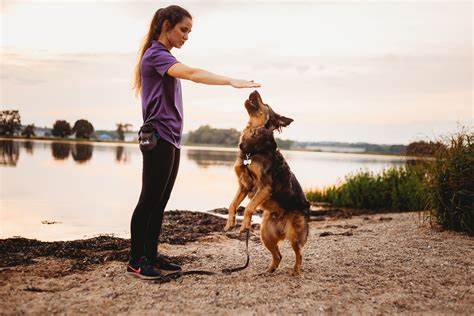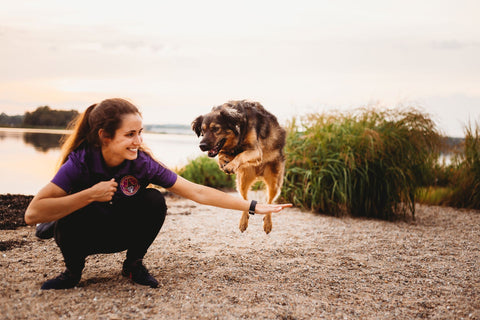Introduction
Begin by explaining the benefits of using play to teach dogs new tricks. Highlight how play engages a dog’s natural instincts, making learning fun and effective. Emphasize the dual benefits of physical exercise and mental stimulation, and how it strengthens the bond between the dog and the owner.
The Importance of Play in Dog Training
1. Physical Exercise
- Energy Management: Explain how play helps manage a dog’s energy levels, making them more receptive to learning new tricks.
- Health Benefits: Discuss the overall health benefits of regular physical activity, including improved cardiovascular health and weight management.
2. Mental Stimulation
- Engaging the Mind: Highlight how play engages a dog’s mind, helping to prevent boredom and destructive behaviors.
- Enhancing Focus: Explain how incorporating play into training sessions can improve a dog’s focus and attention span.
3. Strengthening the Bond
- Building Trust: Discuss how play builds trust between the dog and the owner, creating a positive and supportive training environment.
- Positive Association: Emphasize the importance of creating positive associations with training through play.

Preparing for Play-Based Training
1. Choosing the Right Toys
- Interactive Toys: Recommend interactive toys such as balls, frisbees, and tug ropes that can be used to teach various tricks.
- Safety First: Discuss the importance of choosing safe, durable toys that are appropriate for the dog’s size and chewing habits.
2. Setting Up a Play Area
- Safe Environment: Describe how to set up a safe play area, free from hazards that could injure the dog during play.
- Designated Space: Suggest designating a specific area for play-based training to help the dog distinguish between playtime and rest time.
Incorporating Play into Training Sessions
1. Fetch
- Teaching Fetch: Provide a step-by-step guide to teaching fetch, starting with getting the dog to chase the toy and gradually teaching them to bring it back.
- Advanced Tricks: Explain how to use fetch to teach advanced tricks like “drop it” and “take it.”
2. Tug-of-War
- Rules of Tug-of-War: Discuss the rules for safe tug-of-war play, ensuring it remains a controlled game.
- Using Tug in Training: Explain how to use tug-of-war to teach commands like “let go” and “take it.”
3. Hide and Seek
- Interactive Play: Describe how to play hide and seek with the dog, using their favorite toy or treats.
- Enhancing Recall: Highlight how hide and seek can improve recall skills as the dog learns to find and come to the owner.
4. Agility Games
- Setting Up an Obstacle Course: Provide tips on setting up a simple agility course using household items or DIY equipment.
- Teaching Agility Commands: Explain how to teach commands like “jump,” “tunnel,” and “weave” using the agility course.

Step-by-Step Guide to Teaching Tricks Through Play
1. Basic Commands with Play
- Sit and Stay: Explain how to incorporate toys into teaching basic commands like sit and stay, using the toy as a reward.
- Come: Describe how to use a game of fetch or hide and seek to reinforce the recall command.
2. Intermediate Tricks
- Spin: Provide a step-by-step guide to teaching the dog to spin using a favorite toy to guide them.
- Shake Hands: Explain how to teach the dog to shake hands, using a toy to encourage the lifting of the paw.
3. Advanced Tricks
- Roll Over: Describe the process of teaching roll over, using a toy to guide the dog through the motion.
- Play Dead: Provide tips on teaching play dead, using a toy or treat to encourage the dog to lie down and stay still.
Using Play to Reinforce Good Behavior
1. Positive Reinforcement
- Rewarding with Play: Discuss the importance of using play as a reward for good behavior, reinforcing positive actions.
- Timing the Reward: Emphasize the importance of timing when rewarding with play, ensuring the dog associates the reward with the desired behavior.
2. Redirecting Unwanted Behavior
- Distraction Techniques: Explain how to use toys and play to distract and redirect the dog from unwanted behaviors.
- Consistent Commands: Highlight the importance of using consistent commands and positive reinforcement to shape the dog’s behavior.

Common Challenges and Solutions
1. Short Attention Spans
- Keeping Sessions Short: Recommend keeping training sessions short and engaging to maintain the dog’s interest.
- Mixing Play and Training: Suggest alternating between play and training to keep the dog engaged and prevent boredom.
2. Overexcitement
- Calm Playtime: Provide tips on calming an overexcited dog, such as using quiet toys and practicing calm behavior during play.
- Controlled Play: Emphasize the importance of maintaining control during play to prevent the dog from becoming too excited.
3. Inconsistent Performance
- Consistency in Training: Highlight the importance of consistency in commands and rewards to reinforce learning.
- Patience and Persistence: Encourage patience and persistence, understanding that dogs learn at different rates.
Case Studies and Testimonials
1. Real-Life Experiences
- Owner Testimonials: Share testimonials from dog owners who have successfully used play to teach their dogs new tricks.
- Positive Outcomes: Highlight the positive outcomes and benefits observed, such as improved behavior, increased bonding, and enhanced learning.
2. Case Studies
- Success Stories: Provide detailed case studies of dogs with specific training challenges that were overcome through play-based training.
- Before and After: Include before and after stories to illustrate the improvements in the dog’s skills and behavior.
Conclusion
Summarize the key points about using play to teach dogs new tricks, emphasizing the importance of choosing the right toys, creating a positive training environment, and incorporating play into training sessions. Highlight the benefits of play-based training for the dog’s physical and mental health, as well as the strengthened bond between the dog and owner.
Call to Action
Encourage readers to start incorporating play into their dog’s training routine and to share their experiences or additional tips in the comments section. Invite them to subscribe to the blog for more dog training tips and advice.
